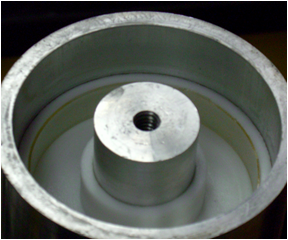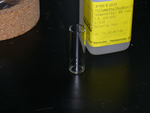
Certain reactions need to be run in an inert environment with no O2 or water vapor present. In most cases, flushing the reaction vessel with an inert gas, such as N2 or argon is sufficient to eliminate unwanted interaction with the atmosphere. This page describes how to flush a vessel to run a reaction under an inert gas environment.

- balance
- weighing boat | paper
- glass vial | plastic > 5mL
- glass | plastic transfer pipette
- Teflon film (~20um thick)
- spin casting head
- heated centrifuge | spinning apparatus
- dry-ice | liquid nitrogen
- Tefzel tape (DuPont)
- 15 cm plastic | wood | metal rod for hanging LCE

This material is prepared using a heated centrifuge in a spin casting head. Before starting material preparation, pre-heat the spin casting head to 60 ~ 65oC.

The first step is preparation of the catalyst solution and reaction solution

- The platinum catalyst solution is prepared as a 1 to 2% weight/weight (w/w) solution in methylene chloride. Typically, this solution is prepared in quantities of 100 to 200uL in a brown vial and stored in the refrigerator.
- Example calculation for 1% (w/w)solution: Add 2 mg of the platinum catalyst to brown glass vial. Add methylene chloride drop wise until the total mass is 100 mg. This will be enough to prepare 5 batches of LCE


- Dry the flask in an oven or with a heat gun and allow to return to room temperature slowly so that condensation does not form on the surface of the glass. Add all required solvents, chemicals, or stir bars to the flask, and place rubber septa over all joints (openings) in the flask.
- Secure the flask with a clamp.
- The picture to the right shows a needle-syringe-hose assembly that is inserted through the rubber septum on the reaction flask. Cut off the 'handle' section at the end of the syringe and insert into the supply and exhaust hoses.
- Connect the exhaust hose to the bubbler ( if available), and the other hose to nitrogen supply source, either a manifold or gas supply tank.
- Gently push the syringe's needle for the exhaust and supply lines through the rubber septum. It is not a problem if there is only one septum on the flask. When you are finished, the entire assembly should be similar to the system shown in the picture on the right.
- Flush the flask with gas for 2 to 3 minutes. If you have a bubbler, a flow rate of a bubble every 2 to 3 seconds is sufficient. Flushing the flask for too long a period of time or at too high a flow rate will drive on solvent and is not recommened.
- Place the plastic covers back over the needle tips. Be careful not to launch the plastic covers the next time you run a reaction under inert gas. For a picture of a bubbler, please see the image at the end of the word or pdf document











































